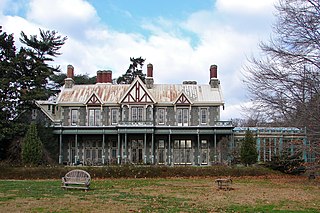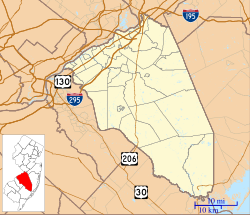
Joseph-Napoléon Bonaparte was a French statesman, lawyer, diplomat and older brother of Napoleon Bonaparte. During the Napoleonic Wars, the latter made him King of Naples (1806–1808), and then King of Spain (1808–1813). After the fall of Napoleon, Joseph styled himself Comte de Survilliers and emigrated to the United States, where he settled near Bordentown, New Jersey, on an estate overlooking the Delaware River not far from Philadelphia.

Bordentown is a city in Burlington County, in the U.S. state of New Jersey. As of the 2020 United States census, the city's population was 3,993, an increase of 69 (+1.8%) from the 2010 census count of 3,924, which in turn reflected a decline of 45 (−1.1%) from the 3,969 counted in the 2000 census.

The Delaware and Raritan Canal is a canal in central New Jersey, built in the 1830s, that connects the Delaware River to the Raritan River. It was an efficient and reliable means of transportation of freight between Philadelphia and New York City, transporting anthracite coal from eastern Pennsylvania during much of the 19th and early 20th centuries. The canal allowed shippers to cut many miles off the existing route from the Pennsylvania Coal Region down the Delaware, around Cape May, and up the occasionally treacherous Atlantic Ocean coast to New York City.

Fairmount Park is the largest municipal park in Philadelphia and the historic name for a group of parks located throughout the city. Fairmount Park consists of two park sections named East Park and West Park, divided by the Schuylkill River, with the two sections together totalling 2,052 acres (830 ha). Management of Fairmount Park and the entire citywide park system is overseen by Philadelphia Parks & Recreation, a city department created in 2010 from the merger of the Fairmount Park Commission and the Department of Recreation.

Charlotte Napoléone Bonaparte was the daughter of Joseph Bonaparte, the older brother of Emperor Napoleon I, and Julie Clary. She was active as an artist.

Skylands is a 1,119-acre (4.53 km2) estate property located in Ringwood State Park in Ringwood, New Jersey, a borough in Passaic County in the state of New Jersey. The Skylands property consists of the historic Skylands Manor mansion, The Castle at Skylands Manor and the New Jersey Botanical Garden; the botanical garden is 96 acres (390,000 m2) and it is open to the public year-round. The Skylands property is within the Ramapo Mountains and it is maintained by the Skyland Association. The property is marketed with the garden as New Jersey State Botanical Garden at Skylands.

Zénaïde Laetitia Julie Bonaparte, Princess of Canino and Musignano was the elder daughter of Joseph Bonaparte and Julie Clary, and the wife of Charles Lucien Bonaparte, who was also her cousin. She joined her father in exile for several years in Bordentown, New Jersey.

Tacony is a historic neighborhood in Northeast Philadelphia, United States, approximately 8 miles (13 km) from downtown Philadelphia. It is bounded by the east side of Frankford Avenue on the northwest, the south side of Cottman Avenue on the northeast, the north side of Robbins Street on the southwest, and the Delaware River and Interstate 95 on the southeast.

Ridley Creek State Park is a 2,606-acre (1,055 ha) Pennsylvania state park in Edgmont, Middletown, and Upper Providence Townships, Delaware County, Pennsylvania in the United States. The park, about 5 miles (8 km) north of the county seat of Media, offers many recreational activities, such as hiking, biking, fishing, and picnicking. Ridley Creek passes through the park. Highlights include a 5-mile (8 km) paved multi-use trail, a formal garden designed by the Olmsted Brothers, and Colonial Pennsylvania Plantation, which recreates daily life on a pre-Revolutionary farm. The park is adjacent to the John J. Tyler Arboretum. Ridley Creek State Park is just over 16 miles (26 km) from downtown, Philadelphia between Pennsylvania Route 352 and Pennsylvania Route 252 on Gradyville Road.

Joseph Lucien Charles Napoléon Bonaparte, 3rd Prince of Canino and Musignano, was born in Philadelphia as the son of Charles Lucien Bonaparte and his wife, Zénaïde Bonaparte.

The Nemours Estate is a 200-acre (81 ha) country estate with jardin à la française formal gardens and a French neoclassical mansion in Wilmington, Delaware, United States. Built to resemble a French château, its 105 rooms on four floors occupy nearly 47,000 sq ft (4,400 m2). It shares the grounds at 1600 Rockland Road with the Nemours Children's Hospital, Delaware, and both are owned by the Nemours Foundation.

Bellevue Mansion was a historic country house in North Philadelphia. The site on which it stood is now between North Marston and North Etting Streets, near 29th Street and Allegheny Avenue.

Locust Grove is a National Historic Landmark estate located on US 9 in the Town of Poughkeepsie, New York. The 200-acre park-like estate includes homes, a carriage house, ice house, trails, a flower garden, and vegetable garden, and it overlooks the Hudson River from a bluff. The property includes a home designed by architect Alexander Jackson Davis for Samuel F. B. Morse, the inventor of the telegraph. An Italianate style mansion, it was completed in 1851.

The Abbott Farm Historic District is a National Historic Landmark archaeological site in New Jersey. It is the largest known Middle Woodland village of its type on the East Coast of the United States. Significant evidence suggests that the Delaware River floodplain was occupied by Paleoindian people for a long period. It was inhabited between 500 BC and 500 AD. It has been a source of controversy and debate around early development.

Glen Foerd is a historic mansion and estate located in the Torresdale neighborhood of Philadelphia, Pennsylvania, overlooking the Delaware River near the mouth of Poquessing Creek.

Bow Hill is located in Hamilton Township, Mercer County, New Jersey, United States. The building was built in 1790 and added to the National Register of Historic Places on January 25, 1973.

Rockwood is an English-style country estate and museum located in Wilmington, Delaware. Built between 1851 and 1854 by banker Joseph Shipley, Rockwood is an excellent example of Rural Gothic Revival Architecture. It was added to the National Register of Historic Places in 1976.

Gibraltar, located at 2505 Pennsylvania Avenue in Wilmington, Delaware, is a country estate home dating from c. 1844 that is listed on the National Register of Historic Places. It takes its name from the Rock of Gibraltar, alluding to the high rocky outcrop on which the house was built. It is located just inside Wilmington's city limits and originally stood at the center of a much larger estate which has over time been reduced to the present area of about a city block in size. The house was originally built by John Rodney Brincklé and inherited by his brother's wife and children, before being bought in 1909 by Hugh Rodney Sharp, who was linked to the Du Pont family through marriage and work. Sharp expanded and remodeled the house, as well as commissioning the pioneering female landscape designer Marian Cruger Coffin to lay out the gardens.

Auburn Valley State Park is a state park, located in Yorklyn, Delaware, United States. The park, which is around 360 acres, preserves the former home and estate of the Marshall family as well as portions of the family's former mills alongside the Red Clay Creek and additional land purchased by the state. The preserve contains several miles of trails open to walking and biking, including a 1.2 mile paved loop. The state owns conservation easements on 160 acres of privately owned land adjacent to the park to help maintain the park's rural character.

Fernbrook Farms is a 230-acre (93 ha) working farm located along County Route 545 in Chesterfield Township in Burlington County, New Jersey. Originally an 18th-century farm, it was briefly a stock breeding farm, known as the New Warlaby Stock Farm, in the 19th century. It now includes an inn, plant nursery, environmental education center, and community-supported agriculture. It was added to the National Register of Historic Places on July 7, 2022, for its significance in architecture and landscape architecture.



























